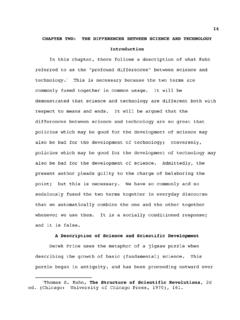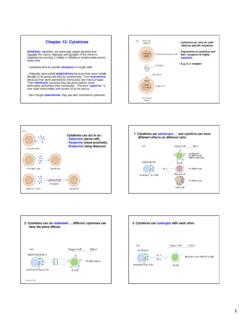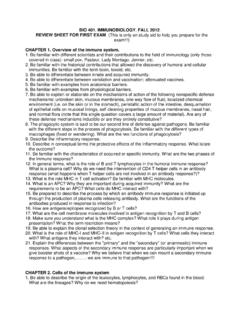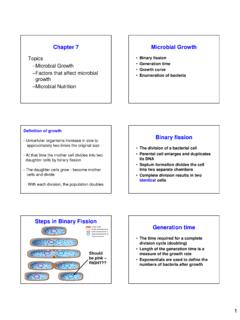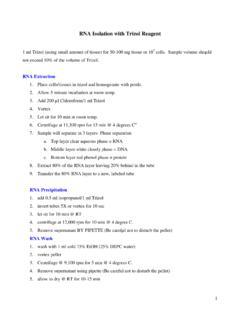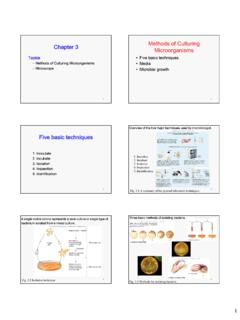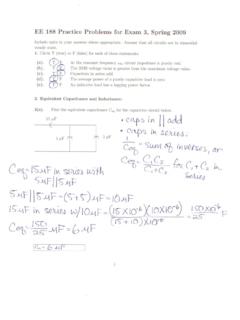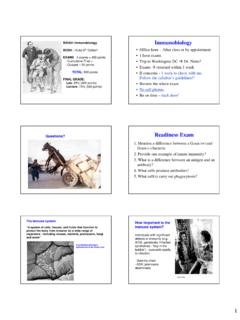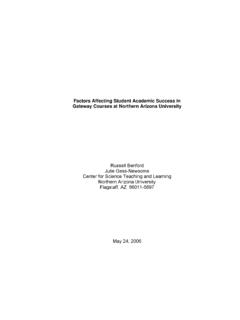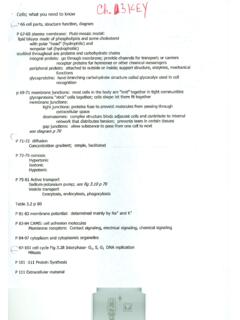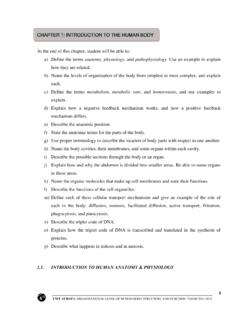Transcription of Basic Antibody Structure
1 1 chapter 4. Immunoglobulin Structureand Function1. Functional Regions2. Types of chains3. Constant &Variable regions4. Glycoprotein- Each heavy and light chainis made up of a number ofdomains(= Ig folding or Igdomains).- Light chains consist of 2 domains (C and V).- Heavy chains have 4-5 domains(depending on the class of Antibody )- Each domain is about 110amino acidsin length andcontains an intrachaindisulfide bond between two cysteines about 60 amino acids chain= 446 aaLight chain= 214aa1122**-150,000 molecular weight-Constant (C) and Variable (V) regionsWhat is the difference?1234 Basic Antibody Structure Multiple myeloma = cancerous plasma cells Monomer = 150,000212 Fab + Fc2 H + 2 L(Fab)2100,000 MW2 (45,000)1 (50,000) 2 (50,0000)2 (25,000) 1 Papain23 PepsinMercaptoethanolRECAP:- The Fc region plays NO role in antigen antigen molecules into 2 Fab fragments and an Fc fragment.
2 -Pepsinbreaks Antibody molecules into an F(ab )2fragment and a VERY SMALLpFc fragment. -Mercaptoethanoltreatment results in 2 heavy and 2 light chains- Complexes of antibodies cross-linked by antigen are called immune complexes .Figure region- amino acid sequence in the C-terminal regions of the H and L chains is the same. region -amino acid sequence in the N-terminal regions of the H and L chains is different. This region provides antibodies with unique regionsare regions within the variable regions (greater specificities).1123 Summary Molecule consists of Constant and Variable regions for both Light and Heavy chains (CH, VH, CL, VL) Ig molecule made of domains Domains ~ 110 aa Each antigen-binding site is made up of the N-terminaldomain of the heavy and the light chains IgM and IgE possess 4 CHdomains (CH1-CH4) while IgG, IgA and IgD have 3 CHdomains (CH1-CH3).
3 Hinge region is missing. Hypervariable regionsin the Variable regions of both H and L the variable domains are three regions of extreme are referred to as the hypervariable regions of the variable domains actually contact the therefore make up the antigen-binding regions are also called the complementarity-determining regions, or ChainLight ChainComplementarity-Determining Regions, or A simulated antigen-binding site showing how the CDRs form points of contact with the chain CDRsH chain CDRsRECAP:-Antibodies are comprised of repeating 110 aa units referred to as domains orIg The C-terminal domains are constant from Antibody to Antibody (within a class). -The constant region domains are responsible for all functions of Antibody other than antigen binding (opsonization, ADCC,complement activation) Biological Function!
4 -The N-terminal domains are variable from Antibody to Antibody and are referred to as variable domains .-The variable domains contain 3 hypervariable regions- the CDRs of the V domains in both H and Lchains make up the antigen-binding EffectorFunctions Binding to Antigen OPSONIZATION: FcR in Macrophages and neutrophils COMPLEMENT ACTIVATION: IgG and IgM ADCC NK cells trough FcR CROSSING EPITHELIAL LAYERS IgA (but also IgM) CROSSING PLACENTA- IgGFc receptors enhance phagocytosis of foreign cells/particles coated with IgGAntibody made in response to foreign cells (cells/viral particles/bacteria etc) will bind to those (and neutrophils) possess receptors for the Fcregion of of macrophage Fc receptors to Antibody bound to cells/particles facilitates and increases phagocytosis of Figure 14-12 ADCC - Antibody -dependent cellular cytotoxicity - mediated by IgG Antibody made in response to foreign cells (cells/viral particles/bacteria etc) will bind to those of the innate immune system (neutrophils, eosinophils, macrophages, NK cells)
5 Possess receptors for the Fc regionof cells bind to Antibody on the surface of foreign cells and release lytic compounds , Dimer, and Pentamer4 Structural Variants of the Basic Immunoglobulin MoleculeDifferent heavy chains can be usedThere are five major types of heavy chain --> five major classes(isotypes) of Antibody - gamma --> IgG (in humans 4 subclasses: IgG1, IgG2, IgG3, IgG4)- mu --> IgM- alpha --> IgA (in humans, 2 subclasses: IgA1, IgA2)- delta --> IgD- epsilon --> IgEThe function of Antibody varies depending on which heavy chain is IgM IgA IgD IgERelative abundance in normal serum:IgG8 - 16 - 4 - 2 - mg/mlIgE17 - 450 ng/ml (< mg/ml)IgGIgAIgMIgDIgEIgGIgAIgMIgDIgE-Mos t abundant in secondary responses-Crosses placenta (FcRn)-Complement activation-Binds to FcR in phagocytesFigure placenta Crosses placenta Crosses placentaComplement Activator Complement ActivatorComplement ActivatorFc binding Fc binding-Best Complement activation-First Ab produced inneonate-First Antibody produced after challenge-Mucosal transport (to some degree)-Monomer on B cells-J chain.
6 Polymeric5-Dimer in mucosal secretions-Mucosal transport- Monomer in circulation- J chain (polymeric) and Secretory components12 Secretory ComponentRole of IgE in allergic reactionsIgE antibodies mediate the immediate-hypersensitivity (allergic) reactions that are responsible for symptoms of hay fever, asthma, hives and anaphylactic shock. IgE binds to Fc receptorson the membranes of blood basophilsand tissue mast cells. Cross-linkageof receptor-bound IgE molecules by antigen (allergen) induces degranulationof basophils and mast cells. A variety of pharmacologically active mediators present in the granules are released, giving rise to allergic manifestations IgD- Role unknown- Present on the surface of MATUREB cells Marker!!- IgA and IgM are secreted across epithelial surfaces- IgG, IgD and IgE can be found only within the body -in serum or IgA and IgM are also found in serum and lymph BUTIN ADDITION can also be found in secretionssuch as mucous secretions, saliva and The IgA and IgM found in external secretions differsfrom that found in serum by the presence of an additional component referred to as the "secretorycomponent".
7 - This component is acquired as the IgA or IgM is transported across the epithelial cell Determinants on Immunoglobulins Abs are glycoproteins and themselves very immunogenic Epitopes on immunoglobulins are divided into: ISOTYPIC ALLOTYPIC IDIOTYPIC6 The function of Antibody varies depending on which heavy chain is regiondeterminants that define each Antibody class and subclassAllelic variation (Allotypes): IgG of a particular class may be slightly different between individuals ( variation in the IgG amino acid sequence)Note: This type of variation has noeffect on antibodyfunction.**Generated by variation in amino acid sequence in the VHand VL. Most exactly, in the CDRs in the V regionsVariation in the antigen binding site(Idiotypes)Remember: Idiotype = Ag binding siteRECAP - Sequence variation in antibodies:1. Different light changes - no significant functional effect2.
8 Different heavy chains - very significant functional effect -isotypic variation3. Allelic variation between individuals - no large functional effect -allotypic variation4. Variation in the antigen-binding site -idiotypic variationB Cell Receptor (BCR):-Short cytoplasmic tail (3-28 aa) ..signaling?-Signaling through a homodimer, Ig- and Ig- - Ig molecule + Ig- /Ig- is the BCR- The homodimer molecule is member of the Igsuperfamily groupIg Superfamily Divergence from a common gene ancestor coding for 110 aa. A member MUST have a typical Ig domain or fold 110 aa with an intra chain disulfide bond 50-70 aa apart. Most members do not bind Ag!! Then, they must facilitate interaction with surface proteins You must know members with roles in: a) immune function, b) Receptor/Signal transduction, and c) Adhesion7 ReceptorsNeonatalImmune FunctionMonoclonal Antibodies Kohler & Milstein 1975 Fusion of normal, activated B cell and plasmacytoma (cancerous plasma cell) Hybrid: immortal, secrete Ab, hypoxanthinePlasmacytoma VS B cell Plasmacytoma: Cancerous plasma cell (Immortal) Does not secrete Abs Lacks HGPRT Normal spleen B cell Limited life span Secretes Abs Possess HGPRT RESULTS:Spleen B cell Hybrid PlasmacytomaDie in culture Immortal, Secretes Lacks HGPRTAb, Possess hypoxanthine (HGPRT)**812345 Applications?
9 Diagnosis Research Treatment Affinity VS AvidityAffinity (polyclonal Ab) = high becauseof multiple epitopesAvidity(monoclonal Ab) = low affinity buthigh avidity because of strong epitope-Ab interaction The EndIgG - Most abundant Ig of internal body fluids (serum, extracellular fluids) - combats microorganisms and toxins within the body - Most abundant Ig in mucous secretions - protects external surfaces of the bodyIgM - The first class of Antibody produced during an immune response. Present both in internal body fluids and in secretions. IgD - functions not well defined. Found mostly on the B cell plasma membraneIgE - Increases during parasitic infections. Causes symptoms of allergy.+--++++Binds to macrophages and polymorphs+++----Binds to mast cells and basophils----++Ability to cross the placenta--+++-++Complement fixation by classical pathwayIgEIgDIgMIgAIgG
